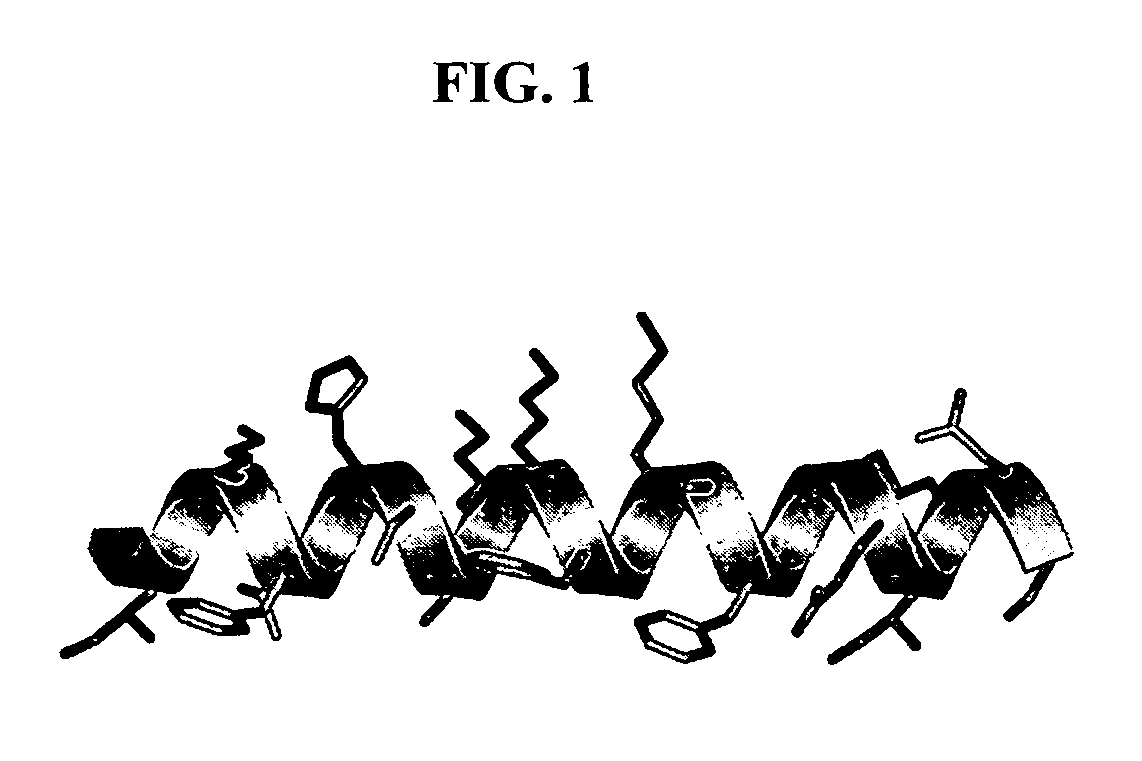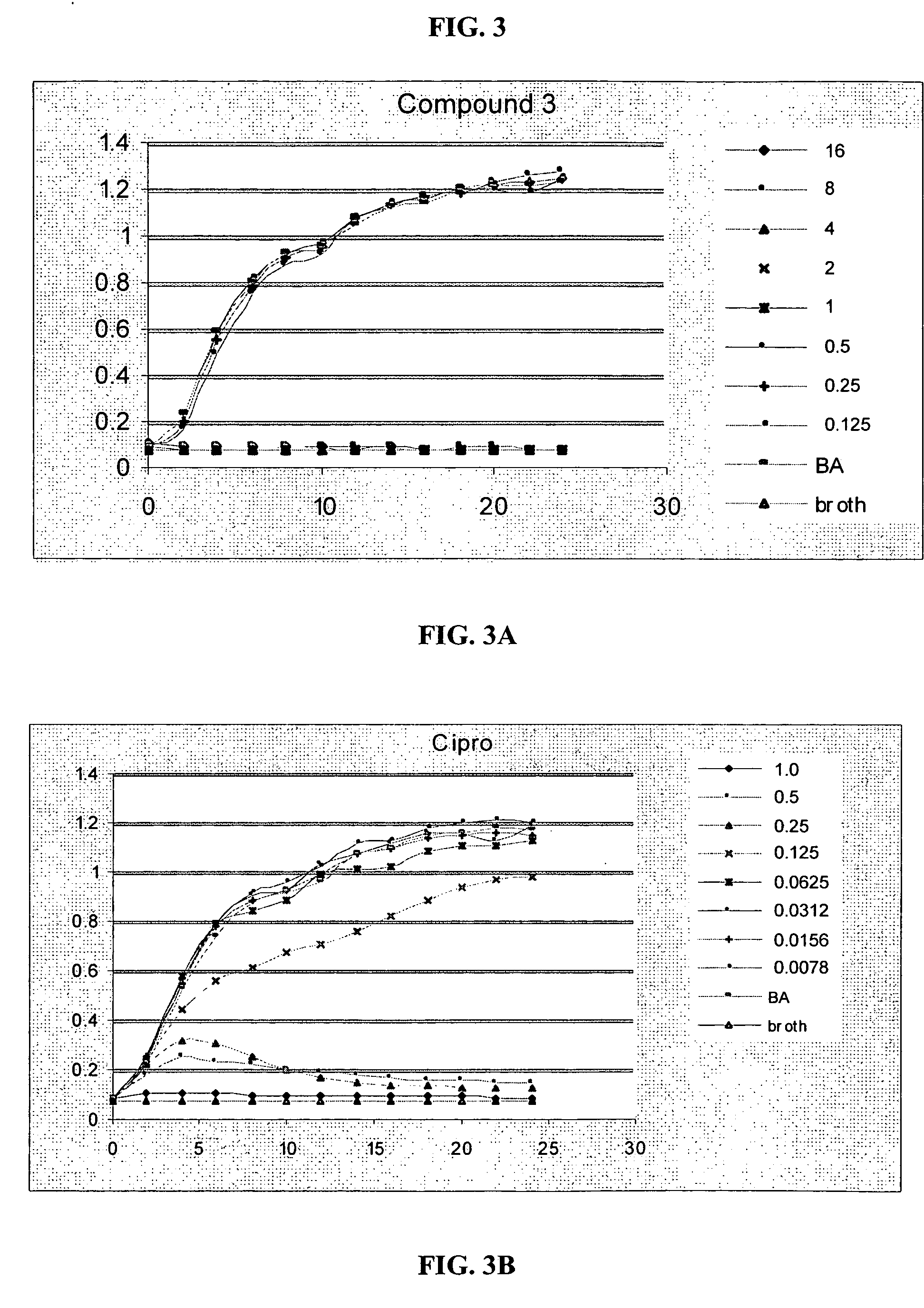Facially amphiphilic polyaryl and polyarylalkynyl polymers and oligomers and uses thereof
a polyarylalkynyl and amphiphilic technology, applied in the direction of antibacterial agents, antinoxious agents, drug compositions, etc., can solve the problems ineffectiveness, and ineffectiveness of bacterial drug resistance, and achieve the effect of translocation of peptides, reducing the resistance of bacterial drugs, and improving drug resistan
- Summary
- Abstract
- Description
- Claims
- Application Information
AI Technical Summary
Benefits of technology
Problems solved by technology
Method used
Image
Examples
example 1
Synthesis of Phenylalkynyl Oligomers
[0290] The following general method can be used to synthesize phenylalkynyl trimer oligomers.
[0291] Starting from dibromobenzoic acid, the appropriate dibromide carboxylate monomer is transformed to the corresponding cyanide and then reduced to amine. The dibromide reacts with diethynyl benzene via Sonogashira coupling to give the final trimer. The guanidinyl derivative is obtained by treating the amine with N,N′-bis(tert-butoxycarbonyl)-1H-pyrazole-1-carboxamidine followed by Boc deprotection. See, for example, Arnt, L, and Tew, G. N., J. Am. Chem. Soc. 124:7664-7665 (2002), with supporting information (see pg. 7665) that includes experimental procedures and chompound characterization (available over the internet at http: / / pubs.acs.org).
[0292] Phenylalkynyl trimer 3 was synthesized according to this procedure, as illustrated in FIG. 2. Starting from dibromobenzoic acid, dibromobenzoic acid monomer was transformed to the corresponding cyanide a...
example 2
Antimicrobial Activities of Phenylalkynyl Oligomers
[0293] A series of phenylalkynyl trimer oligomers was tested for in vitro antibacterial activity and for selectivity for bacterial or mammalian cells.
[0294] Antibacterial assays were performed using a modification of the standard microbroth dilution assay recommended by the National Committee for Clinical Laboratory Standards (NCCLS) which has been developed for determining in vitro antimicrobial activities of cationic agents (Liu, D., and DeGrado, W. F., J. Amer. Chem. Soc., 123:7553-7559 (2001); Steinberg, D. A., et al., Antimicrob. Agents Chemother. 41:1738-1742 (1997); Yan, H., and Hancock, R. E. W., Antimicrob. Agents Chemother. 45:1558-1560 (2001); Amsterdam, D., “Susceptibility testing of antimicrobials in liquid media,” in Antibiotics in Laboratory Medicine, 4th edition, Loman, V., ed., Williams and Wilkens, Baltimore, Md. (1996), pp. 52-111). Modifications were made to minimize loss of the antimicrobial agent due to adsor...
example 3
Antibacterial Activity of Phenylalkynyl Oligomers Against the Category A Biopathogens Bacillus anthracis, Francisella tularensis, and Yersinia pestis
[0300] To measure efficacy against potent biowarfare pathogens, MIC100 values against B. anthracis and Y. pestis were determined for the phenyl alkynyl oligomer Compound 3 of Example 2 above.
[0301] The B. anthracis and Y. pestis cultures were established as follows: For Y. pestis cultures, a blood agar plate was streaked from a tube of frozen Y. pestis (YP.NM 4 stock) and incubated 48 hr at 37° C., 5% CO2. At the end of the second day, a miniculture was set up by adding a colony from the previously prepared blood agar plate into 10 ml of Mueller Hinton II Broth (BBL, Becton Dickinson, Lot # 3338743) and incubated overnight at 37° C., 5% CO2. A maxiculture was set up by diluting the mini-culture at a 1:10 dilution and incubated for 3 hrs at 37° C., 5% CO2 until the OD600 reached 0.115 (approx. 4×107 cfu / ml). An aliquot of the culture w...
PUM
| Property | Measurement | Unit |
|---|---|---|
| Temperature | aaaaa | aaaaa |
| Temperature | aaaaa | aaaaa |
| Volume | aaaaa | aaaaa |
Abstract
Description
Claims
Application Information
 Login to View More
Login to View More - R&D
- Intellectual Property
- Life Sciences
- Materials
- Tech Scout
- Unparalleled Data Quality
- Higher Quality Content
- 60% Fewer Hallucinations
Browse by: Latest US Patents, China's latest patents, Technical Efficacy Thesaurus, Application Domain, Technology Topic, Popular Technical Reports.
© 2025 PatSnap. All rights reserved.Legal|Privacy policy|Modern Slavery Act Transparency Statement|Sitemap|About US| Contact US: help@patsnap.com



